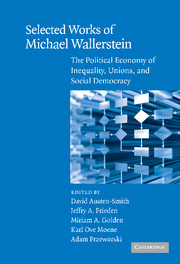 Selected Works of Michael Wallerstein
Selected Works of Michael Wallerstein Book contents
- Frontmatter
- Contents
- Preface and Acknowledgments
- 1 GENERAL INTRODUCTION
- Part I Class Conflict, the State, and Economic Limits to Democracy
- 2 INTRODUCTION
- 3 THE STRUCTURE OF CLASS CONFLICT IN DEMOCRATIC CAPITALIST SOCIETIES
- 4 STRUCTURAL DEPENDENCE OF THE STATE ON CAPITAL
- 5 CAPITAL TAXATION WITH OPEN BORDERS
- Part II The Politics of Labor Organizations
- Part III Inequality and Redistribution
- Part IV Labor and the Nordic Model of Social Democracy
- Other Books in the Series
- References
2 - INTRODUCTION
Published online by Cambridge University Press: 27 January 2010
- Frontmatter
- Contents
- Preface and Acknowledgments
- 1 GENERAL INTRODUCTION
- Part I Class Conflict, the State, and Economic Limits to Democracy
- 2 INTRODUCTION
- 3 THE STRUCTURE OF CLASS CONFLICT IN DEMOCRATIC CAPITALIST SOCIETIES
- 4 STRUCTURAL DEPENDENCE OF THE STATE ON CAPITAL
- 5 CAPITAL TAXATION WITH OPEN BORDERS
- Part II The Politics of Labor Organizations
- Part III Inequality and Redistribution
- Part IV Labor and the Nordic Model of Social Democracy
- Other Books in the Series
- References
Summary
The three articles included in this part reflect the intellectual preoccupations of the time when they were written. But they approached classical questions with new instruments of analysis and generated new answers.
The first puzzle they address concerns the strategies of labor movements under democratic conditions. What motivated this puzzle was the belief, held in the nineteenth century by thinkers across the entire political spectrum, from Thomas Macaulay to Karl Marx, that if workers were to gain political rights in the form of suffrage, they would use this right to confiscate property. Alternatively, if they were to win the right to freely associate, they would destroy productive property by making confiscatory wage demands. The conflict between capital and labor, Marx maintained, was irreconcilable. Even if the economy grew, “profit and wages remain as before in inverse proportions” (Marx 1952a: 37). In turn, Marx (1934, 1952b) and most of his followers expected that, faced with the threat of confiscation by the working class, the bourgeoisie would inevitably turn for protection to arms, and thus subvert democracy. Capitalism and democracy, therefore, could not coexist. Capitalist democracy could be “only the political form of revolution of bourgeois society and not its conservative form of life” (Marx 1934: 18), “only a spasmodic, exceptional state of things … impossible as the normal form of society” (Marx 1971: 198).
Yet they did coexist, uneasily in some countries at times, but quite peacefully and smoothly in several countries of Europe.
- Type
- Chapter
- Information
- Selected Works of Michael WallersteinThe Political Economy of Inequality, Unions, and Social Democracy, pp. 9 - 17Publisher: Cambridge University PressPrint publication year: 2008
References
- 1
- Cited by
